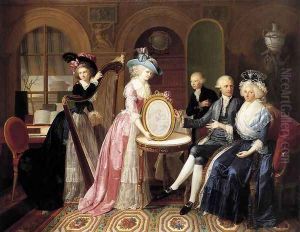Jan Bernard Duvivier Paintings
Jan Bernard Duvivier was a Flemish painter, born in Bruges in 1762. His artistic journey began under the guidance of his father, who was also a painter. Duvivier received his early training at home before moving to Paris to further his studies and career. In Paris, he became a student of Joseph-Benoît Suvée, another accomplished painter from Bruges who was gaining recognition at the French Royal Academy of Painting and Sculpture.
Duvivier's work was predominantly in the genre of portraits, where he demonstrated a strong command of the medium and an ability to capture the likeness and character of his subjects. His style was influenced by neoclassicism, which was prevalent in the late 18th century. He participated in the Paris Salon, the official art exhibition of the Académie des Beaux-Arts in Paris, where his work received positive attention and accolades.
During the French Revolution and the subsequent Napoleonic Wars, Duvivier, like many other artists of the time, experienced the turbulent political and social changes that affected the art scene in Europe. Despite the challenges, he continued to work and attract clients.
Duvivier's career progressed as he gained patrons among the French elite and members of the new political regimes. His ability to adapt to the changing tastes and ideologies of the time allowed him to maintain a successful career throughout the revolutionary period and into the early 19th century.
After a prolific career, Jan Bernard Duvivier passed away in 1837. While he may not be as widely known today as some of his contemporaries, his contributions to portrait painting during a pivotal time in European art history are recognized among art historians and collectors. His works are preserved in various museums, and they offer valuable insights into the style and aesthetics of the period in which he lived and worked.
